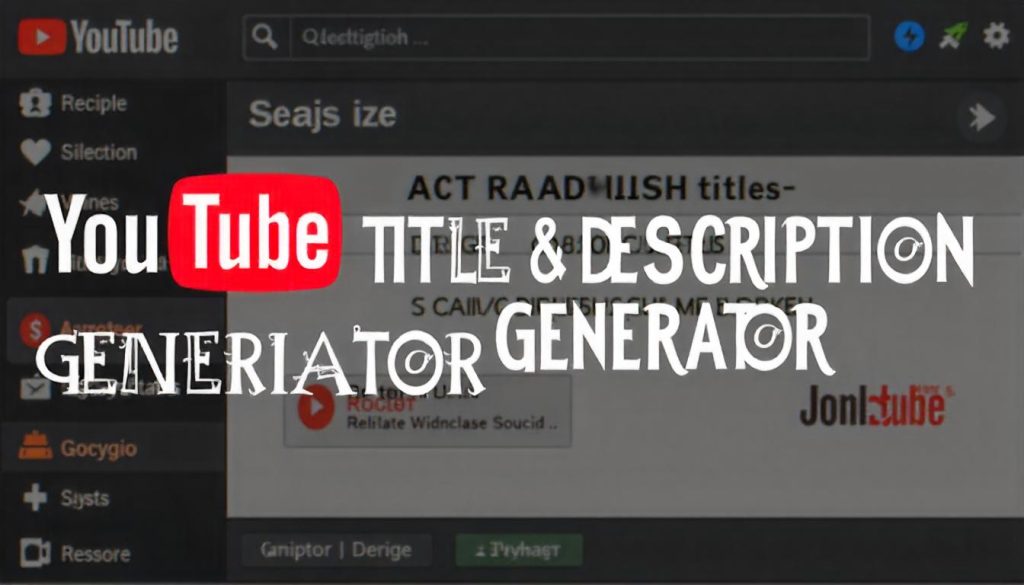
PRO YOUTUBE KEYWORDS RESEARCH TOOL
Get score-based keyword metrics with visual indicators for better video SEO decisions
Analyzing your keyword and generating suggestions…
Keyword Analysis Results
| Keyword | Search Volume | Difficulty | Potential | Actions |
|---|
Video Title Suggestions
Video Description Ideas
Tags Suggestions
Hashtag Suggestions
Global YouTube Keyword Research Tool: The Ultimate Guide to Finding High-Ranking Keywords
If you’re a content creator, marketer, or business owner looking to grow your YouTube channel, keyword research is one of the most important steps in your strategy. The right keywords can help your videos rank higher in YouTube and Google search results, attract more viewers, and ultimately grow your audience.
A YouTube Keyword Research Tool is an essential resource for finding the best keywords to target in your video titles, descriptions, and tags. In this guide, we’ll explore why keyword research matters, how to use a YouTube keyword tool effectively, and the best strategies to optimize your content for maximum visibility.
Why is YouTube Keyword Research Important?
YouTube is the second-largest search engine in the world, with billions of searches every month. Just like Google, YouTube’s algorithm relies on keywords to understand what a video is about and who might be interested in watching it. YouTube Keyword Research
Here’s why keyword research is crucial for YouTube success:
- Higher Search Rankings – Using the right keywords helps your videos appear in search results, increasing organic traffic.
- Better Audience Targeting – Keywords help you understand what your audience is searching for, allowing you to create content that meets their needs.
- Increased Click-Through Rates (CTR) – A well-optimized title and description with relevant keywords can improve CTR, signaling to YouTube that your video is engaging.
- More Views and Subscribers – When your videos rank for high-volume, low-competition keywords, you attract more viewers who are likely to subscribe.
- test ahrefs youtube keyword research
- video research tool
- youtube keyword research
- youtube keyword suggestion tool
- youtube keyword competition checker
- youtube keyword tool
- youtube keywords suggestion tool
- youtube keyword analysis tool
- youtube’s keyword suggestion tool
- ahrefs youtube keyword research
- keyword for youtube
- keyword generator for youtube
- keyword generator youtube
- keyword maker for youtube
- keyword research youtube
- keyword score youtube
- keyword tool for youtube
- keyword tool youtube
How Does a YouTube Keyword Research Tool Work?
A YouTube Keyword Research Tool helps you discover the best keywords by analyzing search volume, competition, and relevance. Some tools also provide suggestions for long-tail keywords, trending topics, and related queries.
Key Features of a Good YouTube Keyword Tool:
✅ Search Volume – Shows how often a keyword is searched per month.
✅ Competition Level – Indicates how difficult it is to rank for a keyword.
✅ Keyword Suggestions – Provides related keywords and phrases to expand your content ideas.
✅ Trend Analysis – Identifies rising trends to capitalize on viral topics.
✅ SEO Score – Rates how well your video is optimized for a keyword.
Popular YouTube keyword tools include:
How to Use a YouTube Keyword Research Tool Effectively
1. Start with Seed Keywords
Begin by brainstorming broad topics related to your niche (e.g., “fitness tips,” “cooking tutorials”). Enter these into the keyword tool to generate more specific suggestions.
2. Analyze Search Volume & Competition
Look for keywords with:
- High search volume (1,000+ monthly searches)
- Low to medium competition (easier to rank for)
Avoid overly competitive keywords unless you already have a strong channel.
3. Target Long-Tail Keywords
Long-tail keywords (e.g., “best home workout for beginners without equipment”) have lower competition and higher conversion rates because they match specific user intent.
4. Check Trending & Seasonal Keywords
Some tools show trending topics. Creating videos on rising trends can give your channel a quick boost in visibility.
5. Optimize Your Video Metadata
Once you’ve selected keywords, use them strategically in:
- Title (Include the main keyword near the beginning)
- Description (First 2-3 sentences should contain the keyword naturally)
- Tags (Add 5-10 relevant tags, including variations of your keyword)
- Closed Captions & Transcripts (Helps YouTube understand your content better)
Best Practices for YouTube Keyword Optimization
✔ Be Natural – Don’t stuff keywords; write for humans first.
✔ Study Competitors – Analyze top-ranking videos in your niche to see which keywords they’re targeting.
✔ Update Old Videos – Refresh titles and descriptions of older videos with new keyword insights.
✔ Track Performance – Use YouTube Analytics to see which keywords drive the most traffic and adjust your strategy accordingly.
Final Thoughts
A YouTube Keyword Research Tool is a game-changer for content creators who want to maximize their reach. By understanding what your audience is searching for and optimizing your videos accordingly, you can significantly boost your views, engagement, and subscriber count.
Whether you’re a beginner or an experienced YouTuber, investing time in keyword research will pay off in the long run. Start using a keyword tool today and watch your channel grow!



